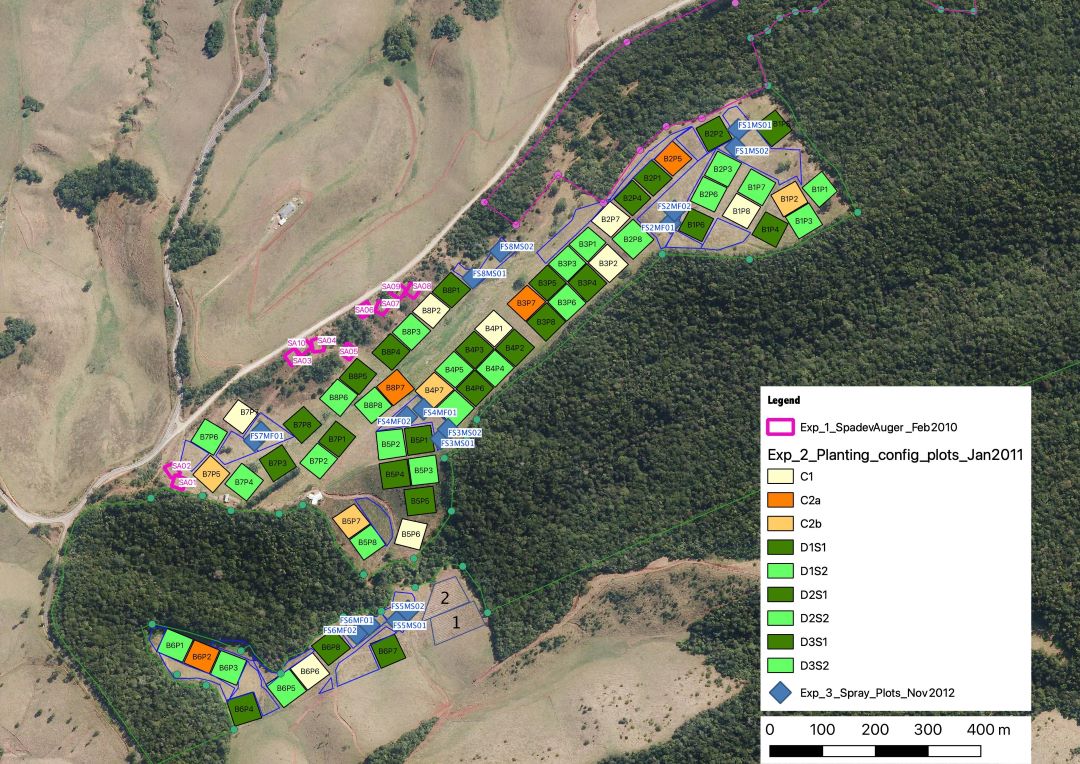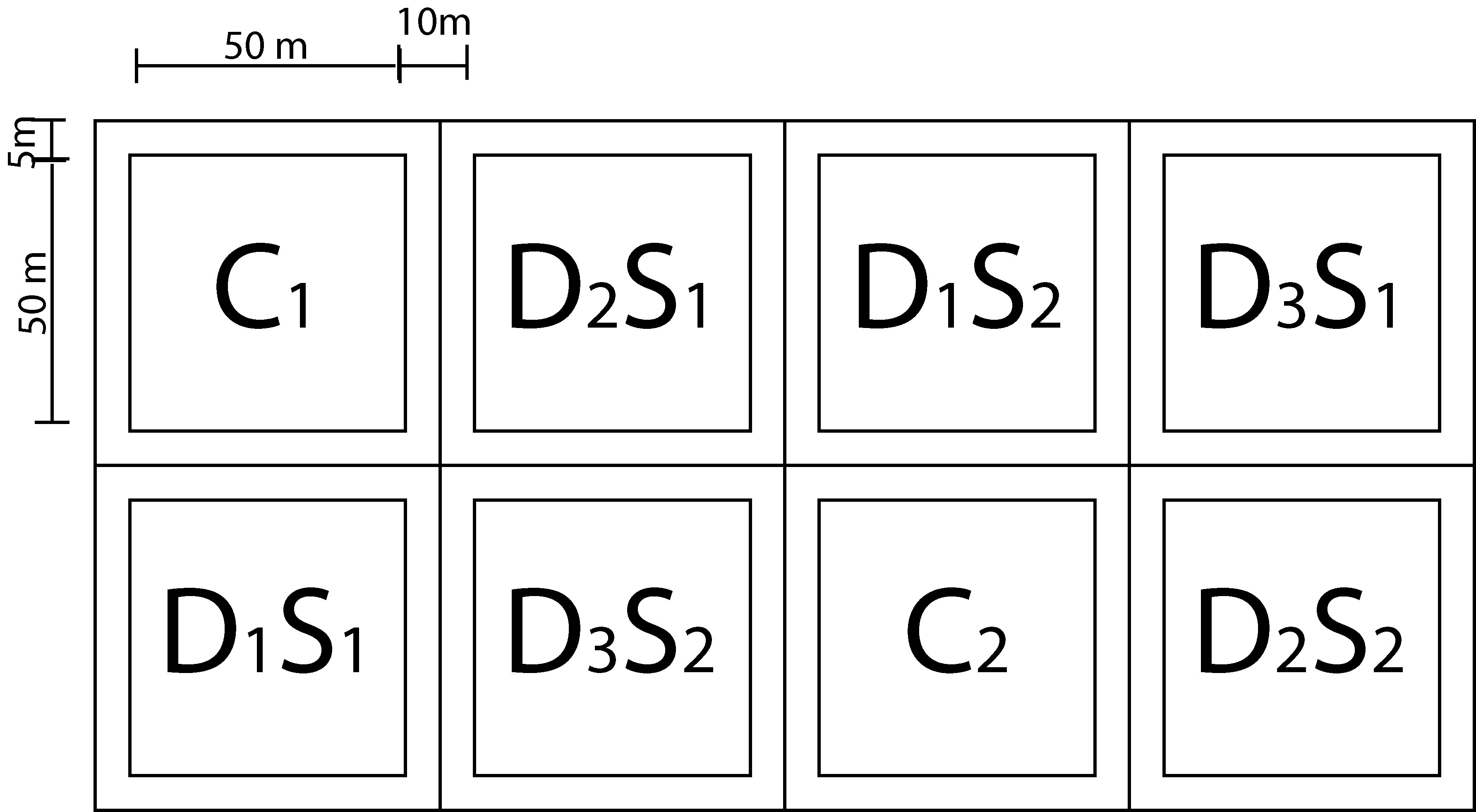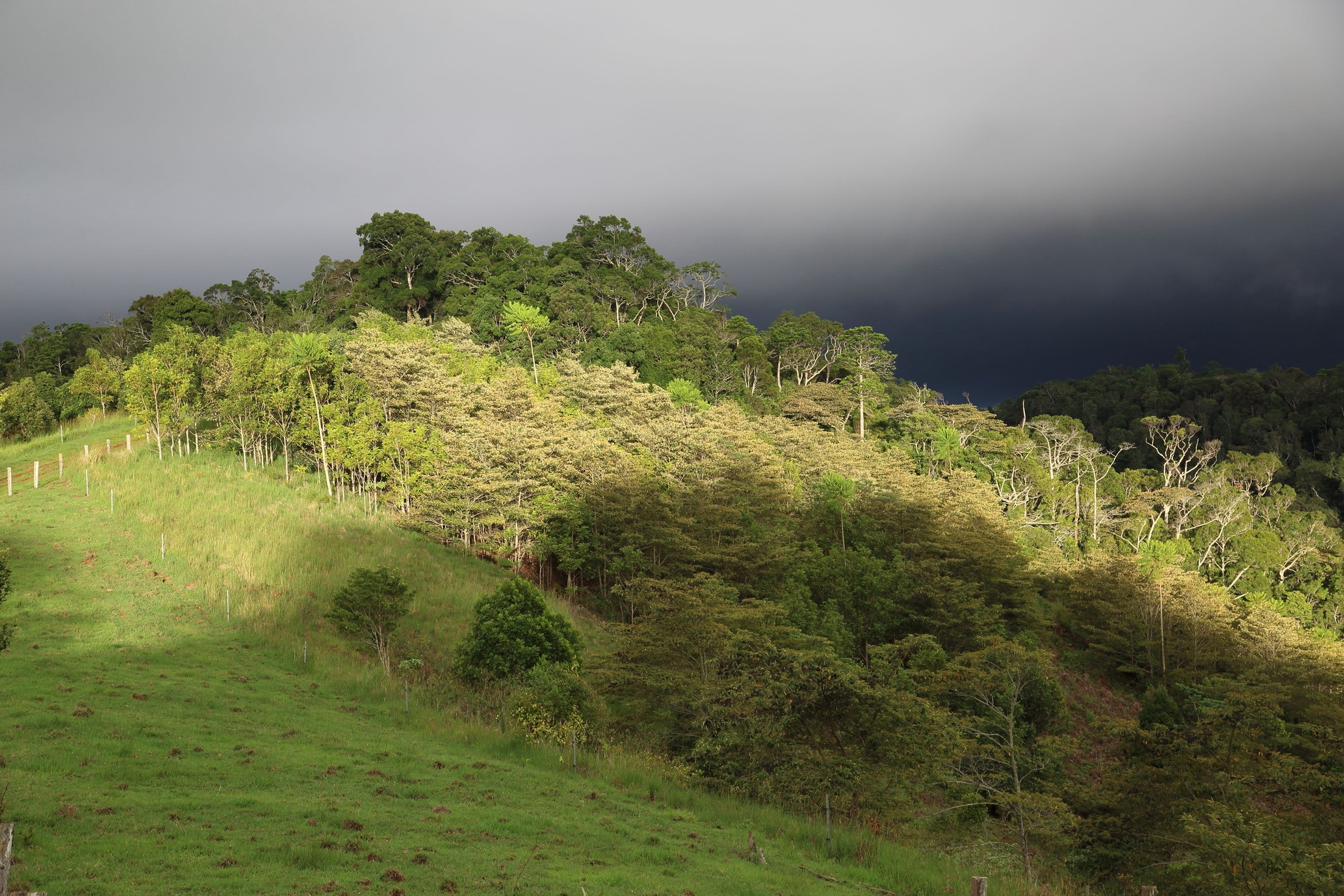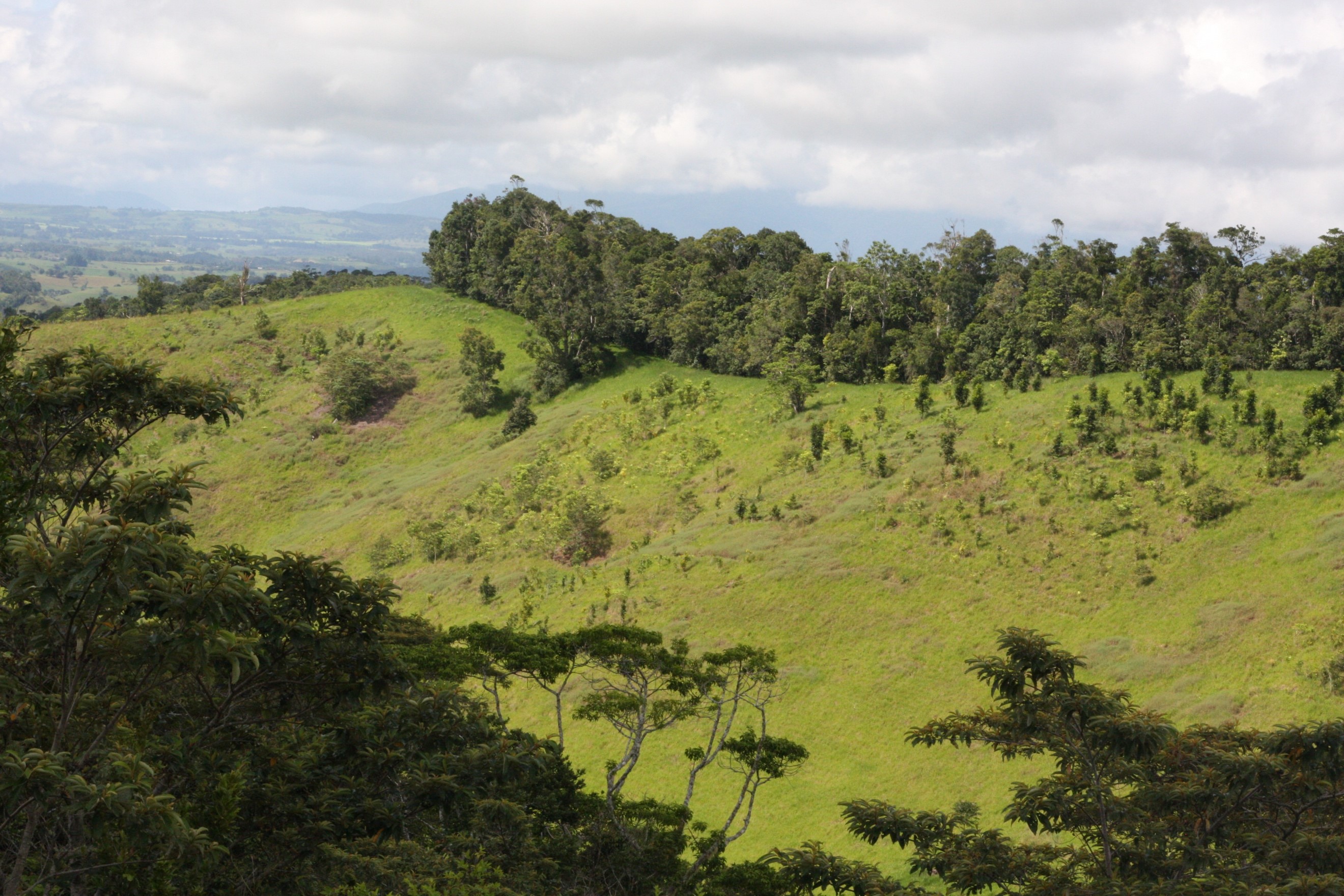Thiaki Rainforest Restoration Trials (Australia)
Located in the uplands of the Wet Tropics rainforest bioregion of north-eastern Australia, the Thiaki Rainforest Restoration Trials were established in 2010 to explore cost-effective and efficient reforestation methods in the context of a warming climate, continued vegetation clearing and increased efforts to restore forests. The project focuses on the range of options that landholders could use to reforest parts of their land, with a range of benefits from wood lots and shelter-belts for agricultural purposes and carbon sequestration forests, to rich biodiversity plantings designed to provide habitat for native species and connectivity between fragmented patches of forest.

Design
Three trials have been established on the Thiaki site over 30 hectares of pasture, most of which had been cleared in the 1940s and grazed continuously. The site had been planted with exotic pasture grasses. Slopes are generally steep, around 30 to 40 degrees. Soils are volcanic deep red earths. Rainfall ranges from 1500 to 2000 mm/a, and is lightly seasonal with a lower rainfall in the winter from June to September.
- The first trial was conducted over two days in February 2010 by a small group of non-professional planters and ourselves. 490 juvenile plants were planted 3 metres apart in ten 25 x 25 m paired plots, five plots by planter spade and five in augered holes.
- The second trial was set up in 2011 using a classic factorial experimental design. We established eight blocks with eight 50 m by 50 m plots in each over 16 ha plus a 1 ha harvest block. Each block includes plots of two planting densities (trees 3 m apart and 1.75 m apart) with three species combinations (monoculture, 6 species, 24 species), and two grass-management systems of one sprayed and one unsprayed control. Local-provenance juvenile trees were grown in forestry tubes and sourced from four local nurseries. They were planted by professional planters and maintained with herbicides and physical removal of grasses and woody weeds for several years after planting until they were established.

- In the third trial, 896 juvenile plants were planted in 16 paired 20 m x 20 m plots in 2013, plus 10,000 in reforestation plantings. Paired plots were immediately adjacent to each other to control for all factors except the effects of planter and herbicide. Within each plot the planting rows were 3 m apart, and planting points 2.5 m apart along the sprayed rows. Fifty-six juvenile plants from 13 species were planted in each plot. One plot pair was fully sprayed out, and the other was sprayed in 1 m wide strips along the contours (the planting rows), leaving grassed strips 2 m wide unsprayed.
Most of the juvenile plants were nursery grown through the seedling stage in ‘forestry tubes’ 120 mm deep and 50 x 50 mm wide. Juvenile plants were grown to approximately 20-30 cm high, usually for 6-12 months, and were all sun-hardened after removal from the nurseries prior to planting. In trial 2, a few thousand juvenile plants were harvested from the wild due to nursery shortfalls. Thirty species were planted across all three trials.
Plants were inserted so that soil covered the root collar. The deepest roots were at least 120 mm below the soil surface, whether planted by spade or auger (the latter only 245 plants). Juvenile plants were planted after substantial rains and in saturated soils, to optimise soil moisture (approaching field capacity), during the mid-summer growing season. In all trials, the planting rows were sprayed before planting with glyphosate (Roundup?, in various concentrations), and after planting with fluazifop-p-butyl (Fusilade? and/or Fuzilier?, both proprietary products).
| Trial | Design | Treatments | Species combinations | Replicates |
|---|---|---|---|---|
| Trial 1 | Paired plots (5) | Planted with forestry spade Planted in augered holes |
5 species in 4 families | 5 |
| Trial 2 | Factorial design (8 blocks, 8 plots within each, including 1 strip-sprayed and 1 unsprayed controls) | Tree spactings (1.75m & 3m) Species combinations (1, 6, 24) |
monoculture 6 species in 6 families 24 species in same 6 families |
8 |
| Trial 3 | Paired plots (8) | Herbicide sprayed in 1m wide strips retaining grassed inter-rows within plots Sprayed whole plots |
13 species in 7 families | 8 |
Site characteristics
| Thiaki: Trial1 (Queensland) | Thiaki: Trial 2 (Queensland) | Thiaki: Trial 3 (Queensland) | |
|---|---|---|---|
| Country | Australia | Australia | Australia |
| Biome | tropical | tropical | tropical |
| Latitude | -17.43361 | -17.43361 | -17.43361 |
| Longitude | 145.51199 | 145.51199 | 145.51199 |
| Soil type | deep, well drained, red-brown pedal, uniform clay soils with basalt coarse fragments and quartz pebbles throughout the profile derived from basaltic rocks | deep, well drained, red-brown pedal, uniform clay soils with basalt coarse fragments and quartz pebbles throughout the profile derived from basaltic rocks | deep, well drained, red-brown pedal, uniform clay soils with basalt coarse fragments and quartz pebbles throughout the profile derived from basaltic rocks |
| Former land use | Agriculture (grazing) | Agriculture (grazing) | Agriculture (grazing) |
| Altitude | 900 - 1000 m | 900 - 1000 m | 900 - 1000 m |
| Plot shape | square | square | square |
| Plot size (m^2) | 625 m² | 2500 m² | 400 m² |
| Plant distance (m) | 3 | 1.75 or 3 | 2.5 (in rows), 3 (between) |
| Number of trees planted | 490 | 27 | 11 |
| Planting date | February 2010 | February 2011 | March 2013 |
| Diversity variables | species richness | ||
| Size species pool | 5 | 25 | 13 |
| Species pool | Syzygium luehmannii Cardwellia sublimis Stenocarpus sinuatus Flindersia brayleyana Guioa lasioneura |
Cryptocarya oblata Endiandra sankeyana Litsea leefeana Neolitsea dealbata Ficus septica Ficus congesta Ficus destruens Ficus obliqua Syzygium luehmannii Acmena resa Rhodamnia sessiliflora Syzygium cormiflorum/kuranda Darlingia ferruginea Cardwellia sublimis Lomatia fraxinifolia Stenocarpus sinuatus Flindersia brayleyana Acronychia acidula Melicope jonesii Melicope elleryana Guioa lasioneura Castanospara alphandii Guioa acutifolia Mischocarpus lachnocarpus |
Cryptocarya sp. Cryptocarya oblata Cryptocarya triplinervis Ficus septica Ficus pleurocarpa Archirhodomyrthus beckleri Syzygium luehmannii Darlingia darlingiana Lomatia fraxinifolia Stenocarpus sinuatus Flindersia brayleyana Guioa lasioneura Elaeocarpus grandis |
| Contact person | Noel Preece Penny van Oosterzee |
Noel Preece Penny van Oosterzee |
Noel Preece Penny van Oosterzee |
| noel@biome5.com.au penny@biome5.com.au |
noel@biome5.com.au penny@biome5.com.au |
noel@biome5.com.au penny@biome5.com.au |
Research
The fundamental research questions being investigated are:
- What are the most cost-effective and efficient planting methods for restoring rainforest?
- How can planting and maintenance methods be improved over commonly-used and costly methods?
- What planting densities and species mixes provide optimal outcomes for different purposes including biodiverse plantings and farm shelter belts and wood lots?
- What functional attributes operate to improve forest establishment and how can these be manipulated and planned?
- How does natural recruitment operate in a plantation?
- When does a planted forest reach structural similarity to remnant rainforest?
- How do animal species respond to different stages, ages and structure of a planted forest?
- When does it become cost-effective to plant a forest for carbon sequestration?
Extra information
Contact info
For extra information you can send an e-mail to the contact persons or explore the publications.


